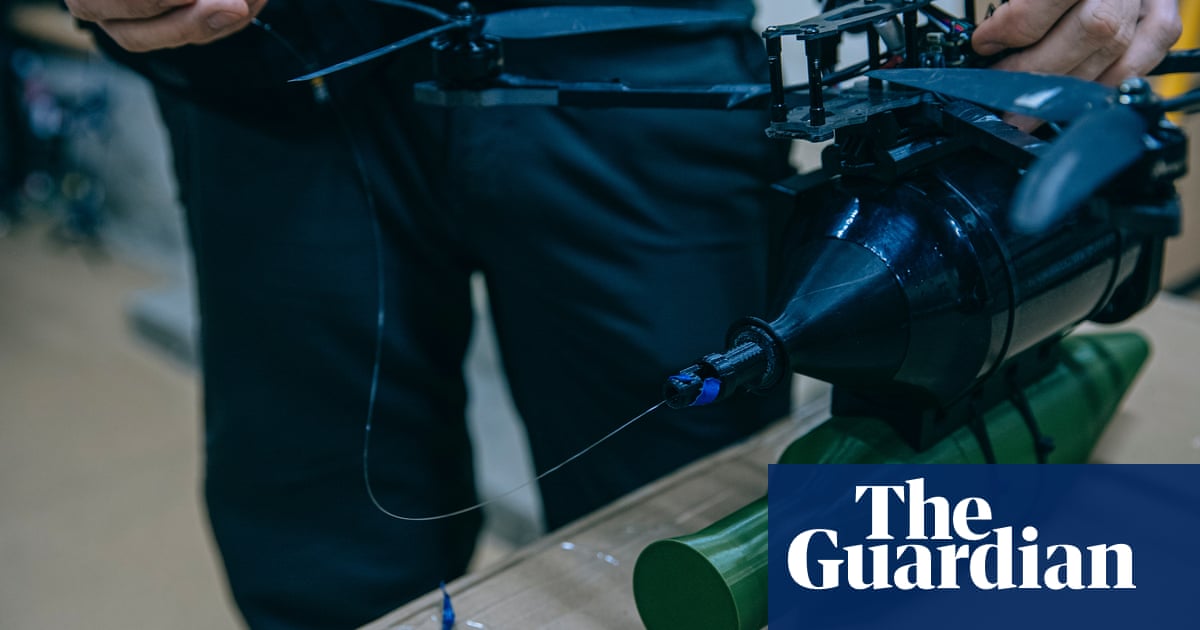At a secret workshop in Ukraine’s north-east, where about 20 people assemble hundreds of FPV (first person view) drones, there is a new design. Under the frame of the familiar quadcopter is a cylinder, the size of a forearm. Coiled up inside is fibre optic cable, 10km (6 miles) or even 20km long, to create a wired kamikaze drone.
Capt Yuriy Fedorenko, the commander of a specialist drone unit, the Achilles regiment, says fibre optic drones were an experimental response to battlefield jamming and rapidly took off late last year. With no radio connection, they cannot be jammed, are difficult to detect and able to fly in ways conventional FPV drones cannot.
“If pilots are experienced, they can fly these drones very low and between the trees in a forest or tree line. If you are flying with a regular drone, the trees block the signal unless you have a re-transmitter close,” he observes. Where tree lined supply roads were thought safer, fibre optic drones have been able to get through.



What kind of comms do the wires allow? Sending guidance and simultaneously receiving video?
What was the physicality of wires back then (and do you know what they are today)? Would it feel like walking into a spider’s web, or how sturdy were/are those wires?
How often would a write break, and would that mean total loss of control or is there some form of fall-back?
Curious minds want to know! Thank you.
Today’s wires aren’t actually wires, they are optical fibers. It must be G.652 or G.657 from telecom use, since that’s commercially available en masse. I think most likely would be G.657.A2 because that can be bent tighter. Here’s an example data sheet from a random google search. I wrote it in a different comment already, but the core has 9 micrometer, the cladding 125 micrometer and the coating 250 micrometer diameter. For telecom applications you’d add at least a mantle, or more likely use a cable with many fibers in little pastic tubes wrapped around a metal core for stability, 12 x 12 is fairly standard. Here of course it’s just a single fiber without mantle being spooled off.
In case of FPV drones, anything up to and including gigabit TCP/IP.
Bidirectional transceivers (so both directions on a single fiber) can do 100 Gbit/s ethernet too. No way you’d do that for drones of course, but just to show how far you can get with a single fiber.
And for unidirectional we’re rapidly approaching 1.2Tb at the top end. 400Gb and 800Gb are becoming pretty standard in the datacenter world. Fiber is wild!
Yes, and that’s before muxing!
I need only 75 GHz of spectrum to send 400 Gbit/s through our country. We’ve currently got a link running between Zürich and Lugano (two amplifier sites in between, before and after the alps), and I’ve got 4400 GHz of usable spectrum with our currently deployed system, so if we needed it and spent like two million dollars we could deploy 23.2 Tbit/s within months, using just our normal commercial stuff, on a single fiber pair.
People who play War Thunder want to know lol you can actually find cut outs that show the internals online. The TOW has been around for awhile.
But the wires were for X and Y navigation. Theres an IR beacon that flashes out the back of the missile. The camera sees the beacon and when you move the controls the missile will follow. Theres a Russian T90 tank that has a defense system that spoofs the beacon. Looks like headlights, called the Shtora-1 check it out.
Wire was made out of the thinnest, strongest metal I’ve ever seen. It would cut your boot if you snagged it and pulled, but it could be cut with scissors.
If you lost a wire the missile would go erratic and would lose control depending on which wire was lost. Really depened on what youre trying to shoot over if you broke a wire. Can’t shoot over buildings.
My favorite fact though, it flys above the tank! Search YouTube for a slow mo and you’ll see what i mean. Explodes from above.